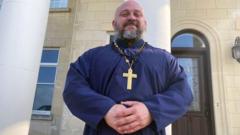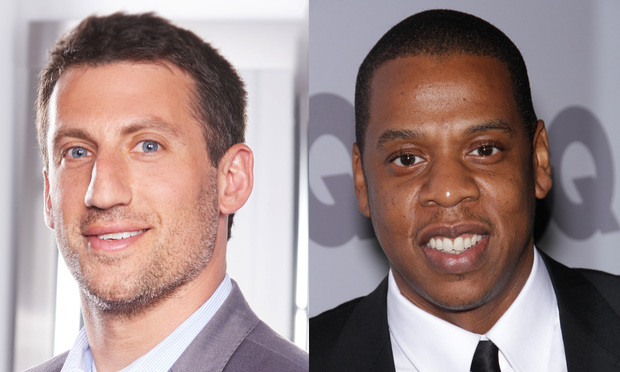Young American men are increasingly drawn to the Russian Orthodox Church, seeking a belief system that embraces a form of 'hyper-masculinity' amidst modern societal challenges. This trend, exemplified by Father Moses McPherson from the Church of the Mother of God in Georgetown, Texas, has seen congregations expand significantly. In the past 18 months, McPherson's church has tripled in size, largely attributed to a surge in male converts who believe that traditional masculinity is under threat.
Father Moses, a robust figure and father of five, has garnered online fame by promoting a virile brand of masculinity through YouTube, where he often critiques behaviors he deems 'too feminine'—like wearing skinny jeans or using an iron. His philosophy resonates with many men who feel under siege from contemporary views on gender roles. One convert, Theodore, a software engineer, expressed that he felt an intrinsic emptiness despite his apparent successes in life, believing that societal messages towards men have become increasingly negative.
The growing interest in the Russian Orthodox Church, especially among men, is supported by data from the Pew Research Center indicating a demographic shift; men now constitute 64% of Orthodox followers, a significant increase over the past decade. Many new adherents are seeking community and stability, especially in light of the disorienting effects of the pandemic. Other converts have opted to embrace home-schooling for their children, driven by the belief that traditional family dynamics must be preserved.
The Orthodox clergy, including figures like Father John Whiteford, support these educational choices as a means of shielding children from modern societal influences. They aim to build a community that avoids conversations around contemporary issues like gender fluidity.
Despite the small size of the Orthodox community in the U.S., its growth represents a shift that mirrors broader political changes. As men seek solace in these ancient traditions, some express admiration for Russia's staunchly conservative views on issues like marriage and family, contrasting sharply with the political climate in the West.
Father Moses critiques Western churches as 'feminized,' resisting trends he associates with emotional and superficial expressions of faith. His strong views attract a cohort of newly devoted members who appreciate the church's differing stance. Elissa Bjeletich Davis, another convert, noted the paradox where some newcomers embrace antiquated ideas about faith and masculinity, while simultaneously seeking a more rigid sense of community.
The digital age is pivotal in this religious shift; influential figures like Father Moses have cultivated vast online followings that further the reach of their philosophies. Collectively, these men are departing from quick-fix consumerism and instead seeking a commitment to family, tradition, and community values.
As some converts imagine relocating to a more conservative Russia, it becomes apparent that their motivations are intertwined with a response to contemporary issues they perceive as threatening traditional structures. Figures like Buck Johnson, a firefighter turned broadcaster, emphasize the importance of long-term thinking about family and community in their newfound faith.
For many, the exploration of Russian Orthodoxy signifies not just a spiritual awakening but a revolt against what they view as the erosion of traditional values in contemporary American life. This unique convergence of faith and identity underscores the broader implications of this movement, as it challenges cultural narratives surrounding masculinity, faith, and community.
Father Moses, a robust figure and father of five, has garnered online fame by promoting a virile brand of masculinity through YouTube, where he often critiques behaviors he deems 'too feminine'—like wearing skinny jeans or using an iron. His philosophy resonates with many men who feel under siege from contemporary views on gender roles. One convert, Theodore, a software engineer, expressed that he felt an intrinsic emptiness despite his apparent successes in life, believing that societal messages towards men have become increasingly negative.
The growing interest in the Russian Orthodox Church, especially among men, is supported by data from the Pew Research Center indicating a demographic shift; men now constitute 64% of Orthodox followers, a significant increase over the past decade. Many new adherents are seeking community and stability, especially in light of the disorienting effects of the pandemic. Other converts have opted to embrace home-schooling for their children, driven by the belief that traditional family dynamics must be preserved.
The Orthodox clergy, including figures like Father John Whiteford, support these educational choices as a means of shielding children from modern societal influences. They aim to build a community that avoids conversations around contemporary issues like gender fluidity.
Despite the small size of the Orthodox community in the U.S., its growth represents a shift that mirrors broader political changes. As men seek solace in these ancient traditions, some express admiration for Russia's staunchly conservative views on issues like marriage and family, contrasting sharply with the political climate in the West.
Father Moses critiques Western churches as 'feminized,' resisting trends he associates with emotional and superficial expressions of faith. His strong views attract a cohort of newly devoted members who appreciate the church's differing stance. Elissa Bjeletich Davis, another convert, noted the paradox where some newcomers embrace antiquated ideas about faith and masculinity, while simultaneously seeking a more rigid sense of community.
The digital age is pivotal in this religious shift; influential figures like Father Moses have cultivated vast online followings that further the reach of their philosophies. Collectively, these men are departing from quick-fix consumerism and instead seeking a commitment to family, tradition, and community values.
As some converts imagine relocating to a more conservative Russia, it becomes apparent that their motivations are intertwined with a response to contemporary issues they perceive as threatening traditional structures. Figures like Buck Johnson, a firefighter turned broadcaster, emphasize the importance of long-term thinking about family and community in their newfound faith.
For many, the exploration of Russian Orthodoxy signifies not just a spiritual awakening but a revolt against what they view as the erosion of traditional values in contemporary American life. This unique convergence of faith and identity underscores the broader implications of this movement, as it challenges cultural narratives surrounding masculinity, faith, and community.





















